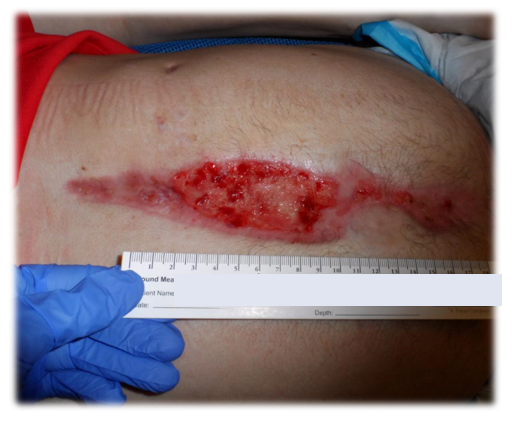This is a young man in his 20’s who is a quadraplegic and suffered a bowel obstruction about 6 months before this photograph was taken. The midline abdominal wound is granulated, but still hasn’t epithelialized. Why? There’s no pressure over this area and it doesn’t appear heavily colonized. I will give you a hint. I’m screening all my patients with the Nestle Mininutritional Assessment tool, and his MNA score is only 7 which indicates that he is malnourished. To make screening easier, we built the MNA into the electronic health record (EHR) and there’s a clinical practice suggestion in the EHR that reminds me to do it. Nutritional screening of patients with non-healing wounds is also a CMS-recognized quality measure.
Perhaps not surprising for a patient who stays inside all the time, his Vitamin D level is only 22.7. Levels less than 30 are associated with poor healing. Yes, it’s also vitamin D Groundhog day. He’s going to be another one of the many patients who has had a non-healing wound for months, but which will be fixed with low-cost and simple nutritional interventions. I will provide Vitamin D3 supplementation, L-arginine, and a lot more calories.
The saddest part of this story is that he’s been malnourished for months, has seen a LOT of different doctors and has been hospitalized several times. Why is it so hard to do the right thing about nutrition?
Additional Links:
- Vitamin D: Don’t Overlook the Sunshine Vitamin
- Don’t Miss This! The Vitamin D Deficiency Epidemic (…and yes, that is a pulsating Dorsalis Pedis artery)
- Vitamin D Insufficiency and Death from COVID-19… And Why a Math Error Means We Don’t Take Enough Vitamin D
- Wound Whisperer: Shhhh… My Secret Vitamin D Treatment for a Surgical Wound Dehiscence

Dr. Fife is a world renowned wound care physician dedicated to improving patient outcomes through quality driven care. Please visit my blog at CarolineFifeMD.com and my Youtube channel at https://www.youtube.com/c/carolinefifemd/videos
The opinions, comments, and content expressed or implied in my statements are solely my own and do not necessarily reflect the position or views of Intellicure or any of the boards on which I serve.




It is sad that so few providers put nutrition on their radar. It isn’t a cure but it can certainly help decrease the cost of healing chronic wounds!